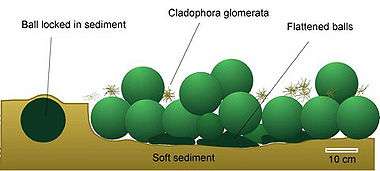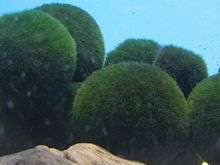Marimo
| Marimo | |
|---|---|
 | |
| Three common growth forms of Aegagropila linnaei, the lake ball proper, "free-floating filaments" and epilithic | |
| Scientific classification | |
| Kingdom: | Plantae |
| Division: | Chlorophyta |
| Class: | Ulvophyceae |
| Order: | Cladophorales |
| Family: | Cladophoraceae |
| Genus: | Aegagropila |
| Species: | A. linnaei |
| Binomial name | |
| Aegagropila linnaei Kützing | |
Aegagropila linnaei, known as Marimo (毬藻, literally "ball seaweed") in Japanese and as Cladophora ball, Lake ball, Mossimo or Moss Balls in English, is a species of filamentous green algae (Chlorophyta) found mostly in a number of lakes in the northern hemisphere. A marimo is a rare growth form of the species where the algae grow into large green balls with a velvety appearance. Colonies of such balls are only known to form in Iceland, Scotland, Japan, Estonia and, in 2014, Australia.[1]
Classification and nomenclature
They were first discovered in the 1820s by Anton E. Sauter in Lake Zell, Austria. The genus Aegagropila was established by Friedrich T. Kützing (1843) with A. linnaei as the type species based on its formation of spherical aggregations, but all the Aegagropila species were transferred to subgenus Aegagropila of genus Cladophora later by the same author (Kützing 1849). Subsequently, A. linnaei has been accommodated in the genus Cladophora in the Cladophorales and has been renamed Cladophora aegagropila (L.) Rabenhorst and Cl. sauteri (Nees ex Kütz.) Kütz. Extensive DNA research in 2002 returned the name to Aegagropila linnaei. The presence of chitin in the cell walls makes it distinct from the genus Cladophora.
The plant was named "marimo" by a Japanese botanist Tatsuhiko Kawakami (川上龍彦 Kawakami Tatsuhiko) in 1898 (Meiji 31). Mari is a bouncy play ball. Mo is a generic term for plants that grow in water. The native names in Ainu are torasampe (lake goblin) and tokarip (lake roller).[2] They are sometimes sold in aquaria under the name "Japanese moss balls" although they are unrelated to moss. In Iceland the lake balls are called kúluskítur by the local fishermen at Mývatn (kúla = ball. skítur = muck) where the "muck" is any weeds that get entangled in their fishing nets. The generic name "Aegagropila" (Αεγαγρόπιλα) is Greek for "goat hair".
Growth forms
There are three growth forms. One is epilithic (growing on rocks) and is usually found on the shaded side of the rocks. Another growth form lives as free-floating filaments, as small tufts of unattached filaments that frequently form a carpet on the muddy lake bottom. The third growth form is the lake ball proper, where the algae grow into sizable balls of densely packed algal filaments that radiate from the center. The balls do not have a kernel of any sort.

Ecology
The existence of Marimo colonies in Lake Akan, Hokkaidō in Japan and in Lake Mývatn in Iceland depends on the adaptation of the species to low light conditions, combined with the dynamic interaction of wind-induced currents, light regime, lake morphology, bottom substrate and sedimentation. The growth rate of Marimo is about 5 mm (0.2 in) per year. In Lake Akan they grow particularly large, up to 20–30 cm (8–12 in). Mývatn, Iceland, has dense colonies of marimo that grow to about 12 cm (5 in) in diameter and form well defined patches on the lake floor at depths ranging from 2–2.5 m (6.6–8.2 ft). The colonies were discovered in 1978 but have shrunk considerably in size since then. The round shape of the marimo is maintained by gentle wave action that occasionally turns it. The balls are green all the way round which guarantees that they can photosynthesize no matter which side is turned upwards. Inside, the ball is also green and packed with dormant chloroplasts which become active in a matter of hours if the ball breaks apart. The wave action also cleans the balls of detritus. As some colonies have two or even three layers of marimo balls, wave action is needed to tumble them around so each ball reaches the light. The spherical shape has a low surface-area-to-volume ratio compared to a leaf, which limits photosynthesis and therefore limits the maximum size of the marimo balls.
Conservation and cultural aspects

The rapidly declining population of lake balls in Mývatn is of special concern, but for unknown reason some of the main patches have all but vanished in recent years. At Lake Akan a great effort is spent on the conservation of the lake balls. This includes an annual three-day marimo festival in which the Ainu people, the indigenous people of Hokkaidō, play an important part. Because of their appealing appearance the lake balls also serve as a medium for environmental education. They bear a certain likeness to the Earth in being green and round and in their need to rotate in order to receive light on all sides. In Japan the marimo has been a protected species since as early as 1920, defined as a natural treasure. Small balls sold as souvenirs are hand rolled from free-floating filaments. The marimo was given a status of protected species in Iceland in 2006. Both Lake Mývatn and Lake Akan are protected, the former as a nature reserve, the latter as a national park.
Awareness of the unique nature of the marimo has not gone unnoticed in the rest of Japanese culture. A widely marketed stuffed toy character known as Marimokkori takes the anthropomorphic form of the marimo algae as one part of its design.
See also
Notes
- ↑ Berry, Sean (2014-09-19). "UFOs on Sydney beach". Yahoo! 7 News Australia. 7News. Retrieved 2014-09-21.
- ↑ Irimoto, Takashi. 2004. Creation of the Marimo Festival: Ainu Identity and Ethnic Symbiosis. Senri Ethnological Studies 66:11–38.
References
- Einarsson, A., Stefánsdóttir, G., Jóhannesson, H., Ólafsson, J.S., Gíslason, G.M. Wakana, I., Gudbergsson, G. and Gardarsson, A. 2004. The ecology of Lake Myvatn and the River Laxá: variation in space and time. Aquatic Ecology 38:317–348.
- Hanyuda, T., Wakana, I., Arai, S., Miyaji, K., Watano, Y. and Ueda, K. 2002. Phylogenetic relationships within Cladophorales (Ulvophyceae, Chlorophyta) inferred from 18S rRNA gene sequences, with special reference to Aegagropila linnaei. J. Phycol. 38:564–71.
- Jonsson, G.S. 1992. Photosynthesis and production of epilithic algal communities in Thingvallavatn. Oikos 64:222–240.
- Nagasawa, S., Wakana, I. and Nagao, M. 1994. Mathematical characterization of photosynthetic and respiratory property regarding the size of Marimo’s aggregation. Marimo Research 3:16–25.
- Yokohama, Y., Nagao, M, Wakana. I. and Yoshida, T. 1994. Photosynthetic and respiratory activity in the inner part of spherical aggregation of "Marimo". Marimo Research 3:7–11.
- Yoshida, T., Nagao, M., Wakana, I. and Yokohama, Y. 1994. Photosynthetic and respiratory property in the large size spherical aggregations of "Marimo". Marimo Research 3:1–6.
- Yoshida, T., Horiguchi, T., Nagao, M., Wakana, I. and Yokohama, Y. 1998. Ultrastructural study of chloroplasts of inner layer cells of a spherical aggregation of "Marimo" (Chlorophyta) and structural changes seen in organelles after exposing to light. Marimo Research 7:1–13.
- Wakana, I. 1992. A bibliography relating to "Marimo" and their habitats. Marimo Research 1:1–12.
External links
| Wikimedia Commons has media related to Aegagropila linnaei. |
- Japan Atlas
- Aegagropila linnaeii on The Aquarium Wiki Encyclopaedia
- Okeanos E-aquarium's Marimo Care Sheet
